Thanks to the people who have contributed to this week’s newsletter: Bev Middleton, Bruno Tigani, Cecilia Macaulay, Frances Gibson, Jo Buckle, Marjory Gardner, Sofiah Fauzi, Victoria Kanicki and Virginia Solomon.
The Just Picked farm in Yan Yean is no more
The Just Picked farm in Yan Yean has closed its doors. The owners, Hans and Maria Hoffman, have sold up and are transitioning into a well-earned retirement. The new owners appear to have no interest in keeping the farm going.
In my opinion, this is sad for at least two reasons. First, Just Picked had a unique place in food production in North East Melbourne being the only local farm that grew and sold to the public a wide range of both vegetables and fruit. As a result, the number of generalist vegetable growers in our Local Food Directory has now reduced from 3 to 2 (Kinglake Vegetables and Sugarloaf Produce) and the number of generalist fruit growers has reduced from 2 to 1 (Kookaberry Strawberry Farm). Just Picked’s demise is a major loss to our local food system. And now that it has gone, it will (presumably) never come back.
Second, although a lot of us talk about the importance of local food production, collectively we appear to have made little effort to retain what is one of the most important farms in the area. As the saying goes, we might talk the talk but we don’t seem to have walked the walk.
I wish Hans and Maria well in what is hopefully a long and exciting retirement.
Growing midyim berries (by Robin Gale-Baker)
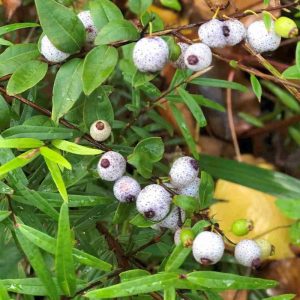 Midyim berry (Austromyrtus dulcis) is a perennial member of the myrtle family which is native to the eastern coastal regions from northern NSW to south-east Queensland. It is a spreading bush with delicious small berries. It can fruit from its first year onwards. In Melbourne, it is a low growing bush. The berries are white with purple specks; they are about the size of a blueberry and also taste like a blueberry with spicy notes. They are used as fresh fruit, fresh in salads and fruit salads, with yogurt or ice cream. They are also used in fruit pies and in jams.
Midyim berry (Austromyrtus dulcis) is a perennial member of the myrtle family which is native to the eastern coastal regions from northern NSW to south-east Queensland. It is a spreading bush with delicious small berries. It can fruit from its first year onwards. In Melbourne, it is a low growing bush. The berries are white with purple specks; they are about the size of a blueberry and also taste like a blueberry with spicy notes. They are used as fresh fruit, fresh in salads and fruit salads, with yogurt or ice cream. They are also used in fruit pies and in jams.
Propagation
Propagation is from seed or cuttings in spring. Seeds take about 4 weeks to germinate and cuttings take about the same time to root. Take a soft-wood or semi-hardwood cutting, strip away about half of the lower leaves and dip in water, then in hormone rooting powder, and insert into a mix of damp perlite and vermiculite. Keep well watered.
Position and soil
Choose a location with filtered light (i.e. some sun, some shade). Midyim berry is an understory plant and gains protection from Melbourne frosts by being placed under trees, where its spreading habit nicely covers the ground. Plants placed in full sun will be denser and those in shade or filtered light will be more open. Midyim berry is not overly fussy about soil but does well with compost and well-rotted manure dug into the soil prior to planting. Add more compost after harvesting in autumn. It also requires well drained soil. It grows well in large pots.
Planting
Dig a hole at least as deep as the root ball, deeper if you need to add compost and rotted manure, and twice as wide. Tease out the roots before planting and backfill with soil. Keep well watered until well established. Mulch well – I prefer sugar cane mulch as it helps to keep the berries clean and they don’t fall through it.
Pruning
Prune after harvest in autumn but also regularly during the year to increase berry production. Berries produce on older wood so lightly prune the new foliage every few months.
Watering
Watering is important while the bush is establishing itself. Watering regularly will also ensure abundant berry production, although bushes will also survive in relatively dry conditions.
Harvesting
Net to protect the berries from birds. The berries are ready when they are soft and fall off at a touch. The berries do not store well so eating them fresh and within a few days is best.
Read more of Robin’s articles on our website about growing various fruit trees.
Seed germination on top of paper (by Bruno Tigani)
[Bruno is a local (Lower Plenty) wholesaler of seeds (Griffin Seeds).]
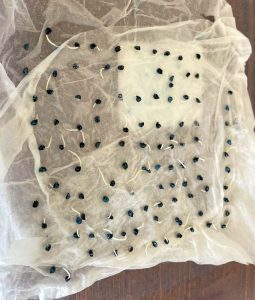 In the commercial vegetable seed industry, the majority of germination tests are done on top of paper. Most of us will be familiar with this method, using cotton or some other similar substrate.
In the commercial vegetable seed industry, the majority of germination tests are done on top of paper. Most of us will be familiar with this method, using cotton or some other similar substrate.
If anyone has any seed of unknown viability, you can approximate soil germination at home by wetting a paper kitchen cloth and placing some seeds on that cloth in an airtight container. For some species, you will see a root emerging within days and, by observing the percentage of seeds that have sent out a root, you can determine the germination percentage of the seeds. Note that, whilst smaller seeds are ok sitting on the paper uncovered, larger seeds like pumpkin or cucumbers may dry out, so another moist cloth on top of the seeds is useful.
In the photo, I am checking on onion seed germination before I sow that seed in a few weeks. I only had serviettes, so not ideal as kitchen cloth is more robust. Onions don’t need any particular warmth to germinate, so these are just on a shelf in my office. For fruiting crops, keeping the container on a warm window ledge for example, will help them along. In this test, after 7 days, about half had emerged. I will check one more time, on day 10 and decide if the seed is good enough to give to growers.
Some tips:
- The cloth just needs to be moist, not wet. I wet the cloth sparingly and let capillary action do the rest.
- Wring the cloth out as much as possible, or use a minimal amount of water, or the seeds may rot.
- If the paper dries during the test, mist sparingly with a sprayer, rather than water drops (which displace the seeds).
- Space them evenly and, when a seed has germinated, I count it and then use tweezers to remove it (or the roots become entangled).
When to harvest leeks
As many of you will know, Bruno (see above) often gives away leek seedlings via this newsletter. One of the recent recipients, Victoria Kanicki, has written in: “My leeks are fattening nicely and I would like to know when they are ready to harvest.” My answer is that she can harvest them at any time after they have reached 2cm in thickness.
Victoria also said: “Many thanks for including the link to Julie’s NATIF website in last week’s newsletter. I was looking for an original and thoughtful gift to offer our friends, who are due to become Australian Citizens in a couple of weeks, and found exactly what I needed on there.”
In passing, Frances Gibson, from Howqua Truffles, reports that 5 newsletter readers, all new to tasting truffles, bought some truffles as a result of the discussions in this newsletter over the last two weeks.
Bev’s soil fun fact of the week
[Bev Middleton lives in Macleod and is from Soil Week Australia.]
‘Top soil’ is the outermost layer of soil. It’s where most of those 6-billion-per-teaspoon organisms hang out and it’s where we grow 95% of our food. So top soil is a big deal but, at about 25cm deep on average, it is also disconcertingly thin.
More on testing soil pH (by Jo Buckle)
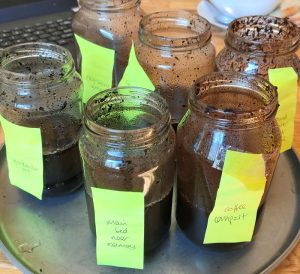 I (Jo) want to thank Stuart Rodda for his July article on testing soil pH. I have been meaning to test my soil for a while but thought it would be too hard; the step-by-step guidance (including the link to buying a cheap but accurate pH meter) was just what I needed.
I (Jo) want to thank Stuart Rodda for his July article on testing soil pH. I have been meaning to test my soil for a while but thought it would be too hard; the step-by-step guidance (including the link to buying a cheap but accurate pH meter) was just what I needed.
I was worried that my soil / compost would be too acidic as my compost contains large quantities of coffee, from the staff at Faraday’s Cage Cafe in Fitzroy, who separate out their food waste and keep it for me; it is about 80% coffee grounds. Sometimes I mix the coffee grounds in with other compost materials and sometimes (if I have too much of it) I separate out the coffee grounds, add sawdust and let the worms do their thing.
Here were my results:
- Soil in various places: 7.2 to 7.8.
- Mixed compost, about 5 months old: 8.3.
- Coffee and sawdust: 6.6 (composted for 2 months) to 7.2 (composted for 1 year).
I am happy that my soil is generally in the right range.
I was surprised that my compost was so alkaline. Is this a problem?
The composted coffee seems to lose its acidity over time (and the worms like it). There might be other problems with so many coffee grounds in finished compost apart from pH levels – not sure whether caffeine or other components will be a problem. Does anyone have any views? One thing is that it’s not very free-flowing and it tends to form sticky mud when wet. I’ll probably spread it around the whole garden rather than concentrating it in one spot.
[Editor: different newsletter readers appear to have rather different views about the efficacy or otherwise of using spent coffee grounds in the garden. For example, here is an article about Sarah Hardcastle’s views and here is an article by Jian Liu.]
Would anyone like to comment on any of Jo’s observations or questions? Email me.
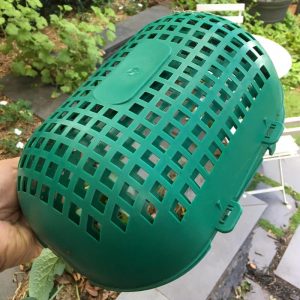 No, you didn’t know
No, you didn’t know
Last week, Jeremy Mather asked what the pictured fruit netting device is called and where it can be bought. No one responded. Can anyone respond this week? Email me.
NERP at Eltham Farmers’ Market on 14th August
North East Region Permaculture (NERP) will be having a stall at Eltham Farmers’ Market this coming Sunday (14th August). The theme will be using your weeds. From 10.15-10.45am, Marina Bistrin will be giving a talk about how you can use your weeds – they are high in nutrition and are ideal to add to your compost to feed your veggies, which in turn, feed you. She will include tips on how to stop your weeds re-growing in your compost. Some weeds are also edible for either people or animals. Take any weeds you would like her to discuss.
Want to volunteer at Bridge Darebin?
Bridge Darebin in Preston is looking for someone to maintain their wicking garden beds. While there will be others to help, they are looking for the volunteer to take on the overall care and responsibility of the beds. The responsibilities will include planting, watering and weeding. They will need to work with Bridge Darebin’s Moon Rabbit Cafe to decide the best plants to plant for kitchen use. Ideally once a week for a couple of hours, or more as necessary in warmer weather. Starting asap. Read more. To apply, email Carli Lombardo (carli@bridgedarebin.org.au).
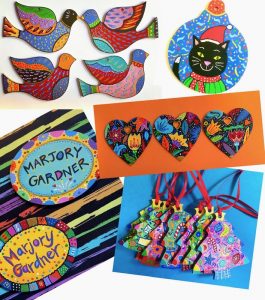 Newsletter reader website of the week – Marjory Gardner
Newsletter reader website of the week – Marjory Gardner
Marjory is a freelance children’s book illustrator (who also “loves gardening!). She also paints personalised name badges, brooches and Christmas decorations, which she sells at local craft markets.
Do you have a website that might be of interest to some of our readership? If so, send me an email and I will include you in a future newsletter.
Which link was clicked most times in the last newsletter?
The most popular link in the last newsletter was The Victorian Government’s pop-up food relief market grants.
 Joke (or pun) of the week
Joke (or pun) of the week
A C, an E-flat, and a G go into a bar. The bartender says “Sorry, but we don’t serve minors.”
Not local but interesting
Playful pantry, fabulous fridge; Sunday, 4th September, 11am-3.30pm; $180 ($40 per hour); Hepburn Springs.
Our fridge is a metaphor for how we let our personal lives become: overcrowded, overcommitted, the flow isn’t happening. If you want to become the designer of your life, fresh and colourful, start with your fridge. It’s easier. Organised by Cecilia Macaulay.
Regular activities over the coming week
Farmers’ markets
- Saturday: Abbotsford and Coburg.
- Sunday: Alphington, Carlton, Eltham and Whitehorse.
Food swaps
- Saturday: Brunswick East, Hurstbridge and Mooroolbark.
- Sunday: zip.
Community gardens
- Thursday: Diamond Valley Library (Greensborough), Edible Hub (Hurstbridge), SEEDs (Brunswick) and Whittlesea.
- Friday: Reynard Street (Coburg) and West Brunswick.
- Saturday: Condell (Fitzroy), Links (Lalor), Macleod Northcote Community Reynard Street (Coburg) and Thrive (Diamond Creek).
- Sunday: Condell (Fitzroy), Fawkner Food Bowls, Pentridge (Coburg), Regent (Reservoir) and West Brunswick.
- Monday: Panton Hill, SEEDs (Brunswick) and Whittlesea.
- Tuesday: Watsonia Library.
- Next Wednesday: Living & Learning Eltham, Macleod, Newton Street (Reservoir), Span (Thornbury) and Sylvester Hive (Preston).
Upcoming face-to-face events – not cooking
Learn about edible forest gardening; Thursday, 25th August, 2-3.30pm; free; Lilydale.
Listen to Jaimie Sweetman from Edible Forest talk about the benefits of edible forest gardening in urban areas, design elements and garden layers of forest gardening, with some samples of some forest garden plants. Organised by Lilydale Library.
Your edible garden, springing into spring! (3 sessions); Sundays, 28th August, 4th and 11th September, each 10am-midday; $62 ($31 per hour); Forest Hill
They will guide you through to an abundant harvest of fresh vegetables and herbs. As well as the usual garden favourites, they will look at vegetables and herbs that may be less familiar. Presenter: Scott Hitchins.
Your edible garden, springing into spring! (3 sessions); Thursdays, 1st, 8th and 15th September, each 10am-midday; $62 ($31 per hour); Forest Hill
They will guide you through to an abundant harvest of fresh vegetables and herbs. As well as the usual garden favourites, they will look at vegetables and herbs that may be less familiar. Presenter: Scott Hitchins.
Introduction to beekeeping (2 sessions); Saturday, 17th September, 9.30am-4.30pm and Saturday, 24th September, 10.30am-12.30pm; $225 ($25 per hour); Blackburn North.
The all day program is highly interactive and includes a live hive opening as well as other hands-on skill building exercises. Background instruction incorporates equipment selection and bee biology in addition to details of the Apiary and Biosecurity Codes of Practice. Included in the course fee are a comprehensive handbook and a copy of the textbook The Australian Beekeeping Manual, 2nd Ed. which retails at $60. Organised by The Beekeepers Club.
Foraging course (5 sessions); 5 Wednesdays starting 28th September, each 6-7.30pm; $330 ($44 per hour); Coburg.
The various sessions will explore specific plants, including identification, nutrition, properties and recipes, ending in tastings of wild food treats. You will learn about: the importance of wild foods; medicine as food; the difference between cultivated foods and wild food; sustainable wildcrafting; safe foraging; identification, nutrition and properties of several plants; and recipes for each of the plants.
Heal with food – heart health; Thursday, 29th September, 6.30-8.30pm; free; Eltham.
Dr Malcolm Mackay will discuss the role of nutrition in pulmonary heart diseases. A healthy meal box will be provided during the event. This is one of a series of monthly talks by health professionals about using food as medicine. Future talks will cover such subjects as asthma, bone diseases, cancer, dementia, depression & anxiety, diabetes, obesity and reproductive health. Organised by Green Karma.
The joy of backyard chooks; Thursday, 29th September, 6.30-9pm; $50 ($20 per hour); Bulleen Art and Garden Nursery.
What you will learn: how to get started with keeping chickens in a suburban backyard; how to house and protect chooks from predators; and how chooks can be used to improve your garden and soil. Presented by Tess.
Edible weeds walk; Saturday, 1st October, at 10.30am-12.30pm and again at 1.30-3.30pm; $25 ($13 per hour); Brunswick East.
What if many of the weeds in our garden were just as edible as the vegetables we tend beside them? What if some of these free, all-too-easy-to-grow uninvited guests were so nutritionally dense that they are just about the healthiest things you could possibly eat? What if many of them also had medical traditions dating back centuries? Well it’s all true! And if you know what to choose, they also taste great. Join Adam Grubb, co-author of The Weed Forager’s Handbook, for a fascinating walk on the wild side, foraging for edible weeds.
Introduction to growing microgreens; Sunday, 2nd October, 10am-1pm; $60 ($20 per hour); Preston.
What you will learn: how CERES produces certified organic microgreens; how to grow pea shoots, radish, and sunflower sprouts at home; and how to plan for a continuous supply of these (enough for all your salad needs). Presenter: Daniel O’Farrell. Organised by CERES.
Growing nutrient dense food; Sunday, 2nd October, 10am-3pm; $115 ($23 per hour); CERES.
This workshop will introduce you to growing better quality, nutrient rich produce at home even if you only have a tiny growing space. It will include: selecting your crops; transforming your soil by focusing on the soil food web; an introduction to soil minerals & going beyond NPK; creating nutrient rich composts; fertilising your plants for maximum nutrition; and harvesting and preparing produce to maintain nutrients. Presenter: Donna Livermore.
In August
- Care of backyard chickens; Thursday, 11th August, 11am-midday; free; Greensborough.
- Mushroom foraging; Thursday, 11th August, 7-9pm; $85 ($43 per hour); Collingwood.
- Growing fruit and veggies in small spaces; Sunday, 14th August, 9.30am-12.30pm; $50 ($17 per hour); Bulleen Art and Garden Nursery.
- Composting and worm farms; Monday, 15th August, 4.30-6pm; free; Kew.
- DIY mushrooms; Saturday, 20th August, 10am-4pm; $165 ($28 per hour); CERES.
- Bees in your backyard; Saturday, 20th August, 10-11am; free; Balwyn.
- Meet the wine makers – Golding Wines; Saturday, 20th August, 3-5pm; $63 ($32 per hour); Northcote.
- Beeswax wraps; Saturday, 20th August, 3.30-5.30pm; $75 ($38 per hour); Panton Hill.
- Compost and worm farms; Sunday, 21st August, 9.30-10.15am; $15 (reimbursable at the nursery); Diamond Creek.
- Growing mushrooms at home; Sunday, 21st August, 10am-12.30pm; $95 ($38 per hour); Alphington.
- Learn about edible forest gardening; Thursday, 25th August, 2-3.30pm; free; Lilydale.
- Cheese and beer masterclass; Thursday, 25th August, 7-9pm; $64 ($32 per hour); Preston.
- Preparing for a summer veggie crop; Saturday, 27th August, 9-10.30am; free; Camberwell.
- Winter fruit tree maintenance; Saturday, 27th August, 9.30am-midday; $55 ($22 per hour); Bulleen Art and Garden Nursery.
- Australian plants expo; Saturday, 27th August, 10am-4pm; $5; Eltham.
- Preparing for a summer veggie crop; Saturday, 27th August, 11.30am-1pm; free; Camberwell.
- Meet the wine makers – Chalmers; Saturday, 27th August, 3-5pm; $63 ($32 per hour); Northcote.
- Australian plants expo; Sunday, 28th August, 10am-4pm; $5; Eltham.
- Your edible garden, springing into spring! (3 sessions); Sundays, 28th August, 4th and 11th September, each 10am-midday; $62 ($31 per hour); Forest Hill
In September
- Grazing board making workshop for women; Thursday, 1st September, 6-8pm; $189 ($95 per hour); Richmond.
- Veggie gardening for beginners; Thursday, 1st September, 6.30-9pm; $55 ($22 per hour); Bulleen Art and Garden Nursery.
- Your edible garden, springing into spring! (3 sessions); Thursdays, 1st, 8th and 15th September, each 10am-midday; $62 ($31 per hour); Forest Hill
- Complete urban farmer (14 sessions); weekly, starting Friday, 2nd September, 9am-3pm; $880 ($10 per hour); CERES.
- The power of rocket stove technology – demonstration evening; Friday, 2nd September, 7.30-9pm; $25 ($16 per hour); Research.
- The art of espalier; Saturday, 3rd September, 9.30am-12.30pm; $55 ($18 per hour); Bulleen Art and Garden Nursery.
- The power of rocket stove technology – workshop build; Saturday, 3rd September, 10am-5pm; $75 ($11 per hour); Templestowe.
- Edible weeds walk; Saturday, 3rd September, 10.30am-12.30pm; $25 ($13 per hour); Brunswick East.
- Edible weeds walk; Saturday, 3rd September, 1.30-3.30pm; $25 ($13 per hour); Brunswick East.
- Setting up a worm farm; Saturday, 3rd September, 2-3.30pm; free; Edendale.
- Caring for backyard chooks; Sunday, 4th September, 2-4pm; $25 ($13 per hour); Edendale.
- Complete urban farmer (14 sessions); weekly, starting Wednesday, 7th September, 9am-3pm; $880 ($10 per hour); CERES.
- Permaculture Design Course (80 hours); on Thursdays from 8th September to 8th December; $595; Kinglake.
- Gardening in small spaces; Saturday, 10th September, 10am-3pm; $115 ($23 per hour); CERES.
- SEEDs Soup Festival; Sunday, 11th September, 11am-5pm; free; Brunswick.
- Introduction to beekeeping; Thursday, 15th September, 11am-midday; free; Greensborough.
- Growing mushrooms at home; Saturday, 17th September, 10am-12.30pm; $95 ($38 per hour); Alphington.
- Introduction to beekeeping (2 sessions); Saturday, 17th September, 9.30am-4.30pm and Saturday, 24th September, 10.30am-12.30pm; $225 ($25 per hour); Blackburn North.
- Tequila & Mezcal Festival; Saturday, 17th September, 5.30pm-midnight; $27 (general admission) or $79 (includes tequilas and tacos); Preston.
- An intro to beekeeping; Sunday, 18th September, 9.30am-12.30pm; $55 ($18 per hour); Bulleen Art and Garden Nursery.
- Backyard chooks for families; Tuesday, 20th September, 2-4pm; $10 per child (accompanying adults are free); Edendale.
- Mushroom growing masterclass; Thursday, 22nd September, 6.30-9.30pm;$145 ($48 per hour); Collingwood.
- Spring veggie gardening; Sunday, 25th September, 9.30-10.15am; $15 (reimbursable at the nursery); Diamond Creek.
- Produce in pots; Sunday, 25th September, 9.30am-12.30pm; $55 ($18 per hour); Bulleen Art and Garden Nursery.
- Foraging course (5 sessions); 5 Wednesdays starting 28th September, each 6-7.30pm; $330 ($44 per hour); Coburg.
Regular events
Eltham trials (walking food tour); various Saturday mornings and Thursday evenings; $65 ($22 per hour); Eltham.
This tour includes a progressive 3-course meal at 4-5 eateries, with stories about the history behind the foods and flavours of the shops. Wander through the local spice shops, butchers and delis. Visit some local retail outlets to browse through the arts and crafts of the region.
- Bakery Hill whisky distillery tour and tasting; various Sundays, various times; $64 ($43 per hour); Bayswater North.
- Beekeeping workshop; roughly once a month; $85 ($34 per hour); Brunswick East.
- Carlton aperitvio food tour; various Fridays, 5-7pm; $89 ($45 per hour); Carlton.
- Cocktail workshop; Saturdays, at 2pm and again at 5pm; $55 ($37 per hour); Northcote.
- Eltham trials (walking food tour); various Saturday mornings and Thursday evenings; $65 ($22 per hour); Eltham.
- Flavours of Coburg food tour; various Saturdays, 10am-1pm; $49 ($16 per hour); Coburg.
- Gin making masterclass; most Saturdays, 10am-1pm; $175 ($58 per hour); Nunawading.
- Ratio Cocoa Roasters behind the scenes chocolate factory tour; various Fridays and Saturdays; $15 ($10 per hour); Brunswick.
Upcoming face-to-face events – cooking
Blokes in the kitchen; Sunday, 9th September, 9am-midday; $40 ($13 per hour); Surrey Hills.
Learn to prepare simple meals with other blokes under Shawn’s guidance. Enjoy a shared meal and conversation to finish the session. Organised by Surrey Hills Neighbourhood House.
Seasonal home cooking – springtime classics (3 sessions); Sundays, 2nd, 9th and 16th October, each 10am-1pm; $110 ($37 per hour); Forest Hill
Prepare seasonal dishes using fresh spring produce. They will show you how to make the most of every part of the vegetables when cooking seasonally, thus reducing waste. Presenter: Scott Hitchins.
Seasonal home cooking – springtime classics (3 sessions); Wednesdays, 5th, 12th and 19th October, each 10am-1pm; $110 ($37 per hour); Forest Hill
Prepare seasonal dishes using fresh spring produce. They will show you how to make the most of every part of the vegetables when cooking seasonally, thus reducing waste. Presenter: Scott Hitchins.
In August
- One pot wonders of the world – slow cooking in a master stock; Friday, 12th August, 5-9pm; $85 ($21 per hour); Panton Hill.
- Dumpling making workshop; Friday, 12th August, 6-9pm; $75 ($25 per hour); Park Orchards.
- Pasta making workshop; Monday, 15th August, 10-11am; $30 ($30 per hour); Park Orchards.
- Italian kids cooking class; Thursday, 18th August, 4.30-6.30pm; $35 ($18 per hour); Surrey Hills.
- Demystifying bread; Thursday, 18th August, 6.30-9pm; $60 ($24 per hour); Park Orchards.
- Pasta making; Thursday, 18th August, 7-9pm; free; Thomastown.
- Gingerbread house workshop; Friday, 19th August, 6.30-8.30pm; $70 ($35 per hour); Park Orchards.
- Sourdough bread making; Saturday, 20th August, 9am-midday; $74 ($25 per hour); Panton Hill.
- Kombucha and kefir; Saturday, 20th August, 1-3pm; $55 ($28 per hour); Panton Hill.
- An artisan chocolate dessert class; Sunday, 21st August, 10am-1pm; $154 ($51 per hour); Alphington.
- Cheddar cheese making; Sunday, 21st August, 10am-5pm; $170 ($24 per hour); CERES.
- Sri Lankan cooking class; Wednesday, 24th August, 6-9pm; $90 ($30 per hour); Surrey Hills.
- Cooking with Jean; Thursday, 25th August, 7-8.30pm; free; Mill Park.
- Make low waste comfort food; Saturday, 27th August, 10am-12.30pm; $30 ($12 per hour); Forest Hill.
- Gnocchi making class; Saturday, 27th August, 10am-1pm; $125 ($42 per hour); Thomastown.
- Veggies in desserts; Sunday, 28th August, 10am-3pm; $115 ($23 per hour); CERES.
- Indian cooking – Punjabi (two sessions); Wednesday, 31st August and Wednesday, 7th September, both 6.30-8.30pm; $110 ($55 per hour); Hurstbridge.
In September
- Italian cooking (2 sessions); Thursday, 1st September and Thursday, 8th September, both 6-9pm; $190 ($32 per hour); Surrey Hills.
- Turkish vegetarian cooking; Friday, 2nd September, 6.30-8.30pm; $65 ($33 per hour); Balwyn North.
- Lovely lemons; Wednesday, 7th September, 1.30-3pm; $5; Greensborough.
- Blokes in the kitchen; Sunday, 9th September, 9am-midday; $40 ($13 per hour); Surrey Hills.
- Sourdough bread; Saturday, 10th September, 10am-12.30pm; $75 ($30 per hour); Park Orchards.
- Growing, cooking, sharing – a harmony of tastes cooking class; Saturday, 10th September, 10am-1pm; $15; Forest Hill.
- Cultural cooking – Indian curries; Saturday, 10th September, 11am-1pm; $50 ($25 per hour); Alphington.
- Pizza making masterclass; Sunday, 11th September, 11am-1.30pm; $99 ($40 per hour); Northcote.
- Cheese making with Tina van Kooten; Wednesday, 14th September, 10am-3pm; $90 ($18 per hour); Yarra Glen.
- Middle Eastern cooking; Thursday, 15th September, 10.30am-1.30pm; $80 ($27 per hour); Park Orchards.
- Sourdough bread workshop; Saturday, 17th September, 9-11.30am; $185 ($74 per hour); Brunswick East.
- Soft goat cheese curd and goat camembert cheese; Sunday, 18th September, 10am-4pm; $170 ($28 per hour); CERES.
- Fermentation for beginners; Thursday, 22nd September, 7-10pm; $112 ($37 per hour); Richmond.
- An artisan vegan chocolate dessert class; Sunday, 25th September, 10am-1pm; $154 ($51 per hour); Alphington.
- Introduction to fermenting at home; Sunday, 25th September, 10am-1pm; $70 ($23 per hour); CERES.
- Gnocchi making masterclass; Sunday, 25th September, 11am-1pm; $99 ($50 per hour); Northcote.
Regular classes
- @drool.aus (Italian); various Saturdays and Sundays; roughly $100 ($40 per hour); Fitzroy and Northcote.
- Al dente cooking (Italian); most Saturdays, 9am-1pm; $155 ($39 per hour); Chirnside Park.
- Become a junior chocolatier; various days and times; $40 ($53 per hour); Yarra Glen.
- Beginners bread making; various Sundays, 8am-2pm; $220 ($37 per hour); Abbotsford.
- Chocolate discovery class; various days and times; $48 ($48 per hour); Yarra Glen.
- Chocolate making workshop; various Thursdays, Fridays and Saturdays; $152 ($38 per hour); Blackburn.
- La Cucina di Sandra (Italian); various evenings, 6.30-10.30pm; $105 ($26 per hour); Richmond.
- Nonna & Mum’s cooking class; monthly on the 4th Thursday, 6-10pm; $20 ($7 per hour); Thornbury.
- Otao Kitchen (various classes); various dates, times and prices; Richmond.
- Rosa’s traditional Italian cooking class; various Saturdays and Sundays; $155 ($39 per hour); Bundoora.
- The ultimate biscuit class; various Tuesdays, 10am-3pm; $162 ($32 per hour); Blackburn.
